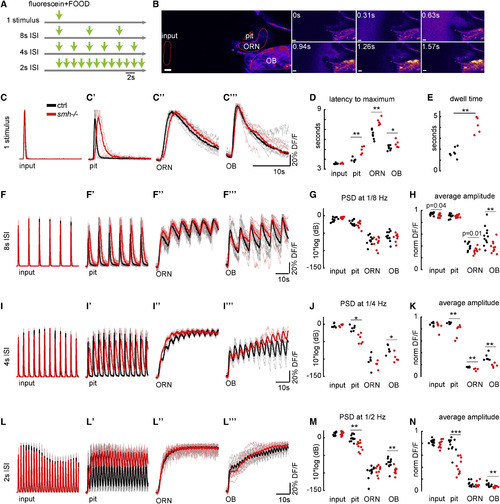Fig. 5
- ID
- ZDB-FIG-170301-12
- Publication
- Reiten et al., 2017 - Motile-Cilia-Mediated Flow Improves Sensitivity and Temporal Resolution of Olfactory Computations
- Other Figures
- All Figure Page
- Back to All Figure Page
|
Dynamic Sampling of Odors via Ciliary Beating Increases the Temporal Resolution of the Olfactory System and Enhances the Detection of Fast Changes in Odor Plumes (A) Fluorescently labeled odor pulses of 0.5 s are delivered by a pinch valve at various inter-stimulus intervals (ISIs) in order to generate odor plumes with increasing frequencies. (B) Montage representing the two-photon microscopy images preceding and following the delivery of a single odor pulse. Time is in seconds. (C–N) Odor kinetics at the input (C–L) and the nose pit (C'–L') as well as odor responses in ORNs (C''–L'') and the OB (C'''–L''') are visualized by two-photon microscopy in 4-day-old HuC:Gcamp6 larvae and are quantified by the percentage change in fluorescence intensity of fluorescein or GCamp6 DF/F in these regions normalized to the maximum for each larva. Control zebrafish is in black, and smh−/− zebrafish with no ciliary beating is in red. (C–E) For a single 0.5 s odor pulse, odors reach the nose pit with a significant delay (D) and reside longer (C’ and E) in smh−/− zebrafish. As a result, ORNs and the OB get activated with a delay (C'', C''', and D). (F–N) With decreasing inter-stimulus intervals, while the odor kinetics at the input are similar(F, I, and L), the odor signals in the nose pit (F', I', and L') and odor responses at the level of ORNs (F'', I'', and L'') and OBs (F''', I''', and L''') are slower in smh−/− zebrafish. The temporal resolution of odor detection is quantified by two different approaches: the power spectral density of odor signals (non-normalized DF/F) at the frequency of odor delivery in the nose pit, ORNs, and OBs (G, J, and M) and the average amplitude of oscillations in normalized odor signals, after the first pulse (H, K, and N). Both of these measures confirm that control animals with ciliary beating are significantly better in detecting fast changes in odor dynamic compared to smh−/− zebrafish with no ciliary beating. Scale bars represent 20 μm. p values by rank-sum test (∗∗p < 0.01 and ∗∗∗p < 0.001). See also Movies S6 and S7. |
| Fish: | |
|---|---|
| Observed In: | |
| Stage: | Day 4 |

